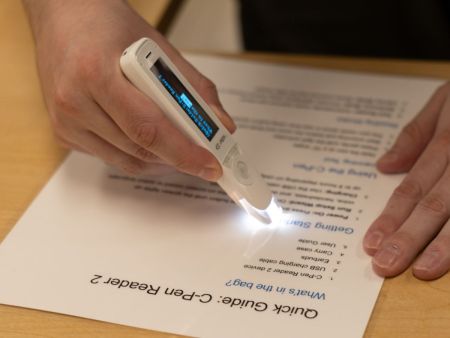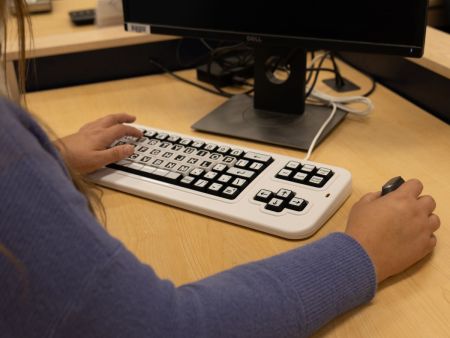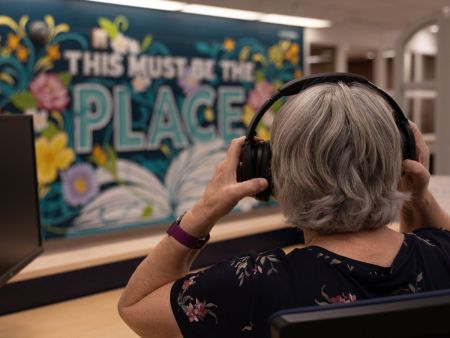Student increasing accessibility on campus through Enabling Accessibility Fund Grant
by Ashley Cyr

When Genna Beed’s (‘25; English, Master’s) path led her to applying for the Government of Canada’s Enabling Accessibility Fund (EAF) youth innovation component during the fourth year of her undergrad at Acadia, it was no surprise. She spent her life up until that time knowing that she wanted to get involved and make a difference. And accessibility has long been her passion.
"I’ve always had a lot of people with disabilities in my life, and I’ve always been exposed to difference,” she explains. In addition to folks with disabilities in her personal life, growing up, Genna spent time volunteering at the Prescott Group in Halifax, a program for teenagers and adults with intellectual disabilities. Genna says it showed her how inaccessible a lot of the world is. Then, when she was a teenager, she contracted Lyme disease, leading to her own personal experience with disability.
So, when Meghan Swanburg (Manager, Accessibility Standards, Compliance and Projects -Built Environment) approached Genna to ask if she would be interested in becoming a Youth Accessibility Leader (YAL) and work with Acadia to apply for an EAF grant, all of the pieces fell into place.
Enthusiastic student involvement in accessibility
A staggering 24 students applied in 2024 to be part of Acadia’s Accessibility Advisory Committee (AAC). The AAC consists of members from across campus and provides recommendations to ensure equitable participation for persons with disabilities in programs, services, initiatives, and facilities at Acadia University.
Because of the overwhelming interest in the AAC from students and the comparatively few spots, with the encouragement of Meghan and Lauren Wilson Finniss (Vice-Provost, Curriculum and Planning), students formed student-led Student Accessibility Action Group (SAAG). They met for the first time in September 2024 to provide a forum for students to discuss accessibility barriers and recommend priority actions.
Meghan is thrilled to see how many students are eager to get involved in accessibility at Acadia. “Students’ response to engaging in conversations on accessibility has been enthusiastic, with outstanding passion, commitment, and experience,” she says.
New equipment for greater accessibility

The funding of $15,229 from the Government of Canada’s EAF youth innovation component will go to two different initiatives on campus: the assistive technology lending library and adaptive gym equipment for the high-performance centre.
The assistive technology lending library, opening at the Vaughan Memorial Library Access Services Desk in September, will allow Acadia students, faculty, and staff to “test out technology that could better support them in their studies and work before committing to purchasing an item,” explains Meghan. “The library also helps to raise awareness of the various assistive technologies available and get feedback on what people find useful.”
The lending library will include equipment like noise-cancelling headphones, ergonomic mice, high contrast large format keyboards, braille label makers, and table-top standing desks.
The piece of adaptive technology that Genna is most excited about are C-Pens. They scan text and convert it to audio in real time. This increases reading independence for folks who need the support, whether they have a visual impairment, dyslexia, or simply want to improve literacy skills.
Accessibility over barriers
Genna’s goal with this grant is to make life for everyone at Acadia, especially people with disabilities, a little better.
“There are barriers within academics itself,” says Genna. “On top of classes, some students are doing extracurricular activities, a thesis, and working. Then you still need to have work-life balance for your physical, emotional, and mental health.”
Living with an invisible disability often makes it difficult for Genna to engage in what she wants to, in the way she wants to. “Something I struggled with through my undergrad was finding work life balance,” she says, knowing she’s not alone in that struggle. “A lot of students are faced with the choice of having good mental health or getting their assignments done.”
Accessibility affects faculty and staff as well. “It’s often difficult for faculty to fully engage because they also experience the barriers in academics,” she explains. “The new tech will make it easier for people to teach and do their jobs, then get to chill and enjoy their lives.”
Training safely with dignity and independence
The high-performance training centre on campus will also see enhancements to their equipment thanks to the new funding. The centre trains Acadia’s varsity athletes and hosts training groups and clients from middle school and community groups to elite athletes in the NHL.
The new gear is designed to adapt existing gym equipment to make it easier for people with accessibility needs to train independently and safely. “It’s all about autonomy,” Nick Pilichos, a strength and conditioning coach and exercise physiologist at the performance centre, explains. “We want to give our athletes as many options as possible and create an inclusive and comfortable environment for them to train in.”
The centre also regularly has para-athletes and individuals needing accessibility adaptations into their facility to experience high-performance training and to help achieve their health and fitness goals. With this new equipment, they will be able to expand their impact within the para and accessible community through community programs such as the S.M.I.L.E. (Sensory Motor Instructional Leadership Experience) Program and others!
Nick's hope is that with the new accessible equipment the centre will attract even more varsity para-athletes to Acadia and increase access for our local community. “Some of our para-athletes are already great mentors for our community, but pairing that mentorship with the upgraded physical space could be huge.”
YOU-th accessibility leaders

Feeling motivated to help make a change? Meghan encourages any students who want to make a difference in accessibility at Acadia to join SAAG. The student-led group meets every three weeks.
You might just be the next Youth Accessibility Leader to bring funding into the university. The Government of Canada recently launched a call for proposals and anyone between the ages of 15 and 30 years old can apply to become a Youth Accessibility Leader and help organizations apply for funding under the EAF youth innovation component.
For more information on how to get involved in SAAG or want to apply to become a Youth Accessibility Leader, students can reach out to accessibility@acadiau.ca or to the co-chair of SAAG, Cairo Hamilton, at 0304716h@acadiau.ca.
“It would be great to apply to this funding again in the fall with another student,” says Meghan.
And if the SAAG isn’t your jam, Genna says “there are tons of organizations on campus, like the ASU always looking for student who want to help out.”
Genna’s words of wisdom for any students out there who want to get involved are to just go for it, and that it’s much easier than it might seem on the outside.
“It’s been really rewarding not just in a ‘wow that’s so cool to accomplish this goal way,’ but also in that I have so many more connections now. Being involved has made my life easier as a student, and it’s been fun to see how different areas of the university work.”
“Meghan is awesome and supported me the whole way through. It was so nice to have that collaborative learning experience!”
